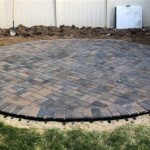Laying a Cement Patio: A Comprehensive Guide
A cement patio can be an ideal outdoor living space, providing a durable and attractive surface for entertaining, relaxing, and enjoying the outdoors. Laying a cement patio is a manageable DIY project for those with basic construction skills, but there are several essential aspects to consider to ensure a successful and long-lasting result.
1. Planning and Preparation:
Before starting, determine the desired size, shape, and location of your patio. Clear the area of any existing vegetation or debris, and mark the perimeter accurately. Excavate the area to a depth of 6-8 inches, ensuring a slight slope (1/4 inch per foot) to facilitate water drainage.
2. Base Preparation:
A stable base is crucial for the durability of your patio. Compact the excavated soil with a plate compactor or hand tamper. Create a layer of compacted gravel or crushed stone (3-4 inches thick) over the soil and compact it thoroughly.
3. Formwork:
Install formwork around the perimeter of the patio using wooden stakes and boards or concrete landscape edging. Ensure the formwork is level and secured firmly to prevent the cement from flowing out during pouring.
4. Mixing the Cement:
For a patio, use a concrete mix specifically designed for outdoor use. Follow the manufacturer's instructions for mixing the concrete. The ideal consistency is workable but not too wet or soupy. Avoid adding water to the already mixed concrete.
5. Pouring the Cement:
Wear appropriate safety gear while pouring the cement. Pour the cement into the formwork slowly and evenly, working in sections to avoid air pockets. Use a screed board to level the cement and a bull float to smooth the surface.
6. Curing and Finishing:
Allow the cement to cure for several days, keeping it moist by covering it with plastic or burlap. Protect the edges from drying out by covering them with damp towels or formwork. After 7-10 days, remove the formwork and apply a concrete sealant to protect the surface from moisture and wear.
7. Expansion Joints:
To prevent cracking due to temperature fluctuations, cut expansion joints into the cement using a concrete saw once it has hardened. Expansion joints should be 1/2 inch wide and spaced every 8-12 feet.
By following these essential aspects, you can successfully lay a durable and attractive cement patio that will provide years of enjoyment. Remember to take your time, pay attention to details, and use quality materials to ensure a long-lasting result.

Pouring Concrete Patio What Could Go Wrong With Doing It Yourself

How To Build And Lay A Patio Marshalls

Diy Concrete Patio In 8 Easy Steps How To Pour A Cement Slab

How To Lay A Patio On Concrete Or Over Paving Marshalls

How To Plan Pour Your Diy Concrete Patio Liberty Ready Mix

Quikrete Building A Concrete Patio

How To Pour A Concrete Slab Diy Family Handyman
Lay Your Patio Step By Driveway Paving Dublin Contractor Granite Patios Gravel

How We Install Concrete Patios A Visual Ilration

Quikrete Building A Concrete Patio








